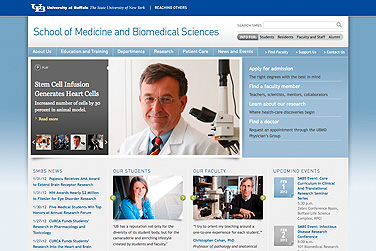News
Web initiative fires up

The School of Medicine and Biomedical Sciences was one of the first units to develop a new website as part of the DCT.
-
 Print
Print -
 Comments
Comments
-
Helping your site succeed
To assist DCT participants throughout the process, University Communications developed the UB Web Management help site. Read story.
The websites, they are a changin.’
New technology and new methods are now available—at no cost—to all units at UB to help them create and manage better websites as part of a university-wide initiative called the Digital Communications Transformation (DCT). All units are invited and strongly encouraged to participate in the DCT.
Backed by extensive research and analysis of best practices among peer Association of American Universities institutions, the DCT is a project several years in the making. It developed from a joint effort among the School of Medicine and Biomedical Sciences, UBit and the Office of University Communications.
The Digital Communications Transformation employs both a new technology—known as the UB Content Management System, or UBCMS—and a new process.
The UBCMS is the state-of-the-art technology platform that makes it easy for units to develop a vastly improved website without the need for knowledge in Web coding and programming. The new method guides users through the process of creating a better website, from planning and writing for the Web to maintaining the site after it has been launched.
Web visitors likely already have noticed some major changes. Most notably, the UB homepage was redesigned and relaunched during the fall semester using the UBCMS.
The School of Medicine and Biomedical Sciences worked closely with University Communications and UBit to pilot the new approach over the past two years. Visitors to the SMBS site now will see a much cleaner, better-organized website that quickly provides a wealth of school news and events, in addition to contact information for faculty members and mini-profiles of students, alumni and faculty.
“The old website was pretty good. But the problem was—it’s like when you move and you get rid of a lot of stuff,” says Kenneth Blumenthal, chair of the Department of Biochemistry in the medical school. “The old site had lot of stuff we didn’t need. This helped us get rid of that stuff and clean it out.
“I like the new website,” Blumenthal adds. “I think it’s more navigable. People maintain websites in a piecemeal way. This forces you to do it in a more globally effective way. One feature about this that’s really nice is that we know that all of the information we’ve put up there populates all the other sites on which we’re referenced. That’s important because with web browsing, if you don’t find it in two clicks, it’s not there.”
Other sites produced so far include those for the offices of the President and Provost, the Office of Continuing Medical Education, UB 2020 and GetUBGear.com. In addition, a special site was created in the fall for the inauguration of President Satish K. Tripathi.
Why was the DCT necessary?
“Digital communications are pervasive in today’s world,” explains Joseph A. Brennan, associate vice president for university communications. “In order for UB to achieve its most important goals—which include attracting the best faculty in the nation, recruiting a talented and diverse student body and engaging our worldwide alumni and receiving their support—it is critical that we have a compelling, attractive and easy-to-use Web presence.”
Another key to the Digital Communications Transformation is placing more web power in the hands of specific individuals within each unit across campus. “We are empowering communicators in every department to directly plan, publish and manage their websites,” Brennan adds.
“Our new technology is state-of-the-art and simple to use, and it is customized to the needs of the University at Buffalo. I am confident that as more and more units adopt this new approach, it will create a much better Web presence, one that will be far easier for our departments to maintain, and that this will have a major positive impact on our ‘Three E’ goals of efficiency, engagement and excellence.”
In addition to its ease of use, the UBCMS provides opportunities for units across campus to share content, eliminating the need for each unit to create its own repository of common information. The UBCMS already contains ready-to-use content on the Buffalo-Niagara region and the university itself, including enrollment figures and a list of schools and colleges and centers and institutes, as well as a visitor’s guide. Over time, more shared content will be developed.
During the fall semester, a select group of academic and administrative units, including the School of Public Health and Health Professions and University Business Services, began using the UBCMS and will be launching their updated sites over the next several weeks.

Reader Comments